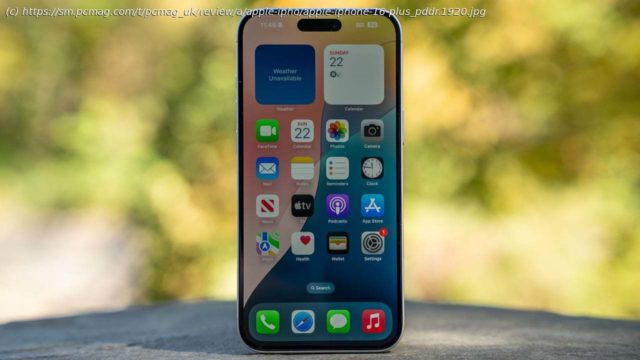An iPhone 16 with a bigger screen and longer battery life
Starting at $899, the iPhone 16 Plus aims to strike a balance between size, features, and affordability. It includes all the characteristics and performance of the iPhone 16 (starting at $799), such as the Action Button, Camera Control, and A18 processor, in a form factor that’s about the same size as the 16 Pro Max (starting at $1,099). Accordingly, the iPhone 16 Plus is easy to recommend to anyone who wants the lower cost of the regular iPhone but the extra screen size and battery life of the Max. For everyone else, the regular iPhone 16 remains our Editors’ Choice winner thanks to its ideal combination of price, size, and performance.Design: Bigger, But Still Manageable
Like the smaller iPhone 16, Apple makes meaningful upgrades to the 16 Plus even though the phone hardly looks changed when compared with its predecessor, the iPhone 15 Plus. The result is a pleasing mix of familiarity that impresses with its newness along the way.
The iPhone 16 Plus is the second-largest iPhone, measuring 6.33 by 3.06 by 0.31 inches (HWD) and weighing 7.03 ounces. The 16 has all the same features as the 16 Plus other than the screen but is smaller at 5.81 by 2.82 by 0.31 inches and 6.0 ounces. The 16 Pro (starting at $999) is close in size to the 16 at 5.89 by 2.81 by 0.32 inches and 7.03 ounces, while the Pro Max is the largest of the bunch at 6.42 by 3.06 by 0.32 inches and 7.99 ounces.
The 16 Plus isn’t quite as easy to carry around and use as the iPhone 16, but you get a larger screen and a longer battery life in return.
Similarly priced Android flagships are slightly smaller, such as the $799 Google Pixel 9 (6.0 by 2.8 by 0.3 inches, 7.0 ounces) and the $799 Samsung Galaxy S24 (5.79 by 2.78 by 0.30 inches, 5.93 ounces).
The iPhone 16 Plus has an aluminum frame and Apple’s Ceramic Shield on either side. Apple says its glass is stronger than the Corning Gorilla Glass Victus found on the Pixel 9 and Galaxy S24. I like the matte finish of the aluminum and glass. Like the rest of the iPhone 16 family, the 16 Plus has an IP68 rating for protection against dust and water. It can be submerged in about 5 feet of water for up to 30 minutes. The Pixel 9 and Galaxy S24 have the same IP rating. Apple offers the iPhone 16 Plus in Black, Pink, Teal, Ultramarine, or White. We received the White model for review.
The 16 Plus has the same Action Button as the iPhone 16. It’s a tiny button high on the left edge and replaces the ringer switch. The default action is to silence the phone when pressed, but you can customize it to open the flashlight or launch the shortcut of your choosing. The 16 Plus also gains the Camera Control key, which is located on the lower portion of the right edge. This button opens the camera with a quick press, snaps a photo with a second press, and records a video with a long press.
You’ll find the power button in its familiar place along the phone’s right edge. The same goes for the USB-C port and down-firing speaker on the bottom. You won’t find a SIM card tray if you’re buying an iPhone 16 Plus in the US because US models rely on eSIM only.
The camera module is the one major design element Apple has changed for the 16 and 16 Plus. The last several generations of iPhones have featured camera lenses at an angle to one another. Apple straightens them out for the iPhone 16 Plus.Display: Mostly Unchanged
The iPhone 16 Plus display is practically identical to that of last year’s 15 Plus. It’s a Super Retina XDR OLED screen that measures 6.7 inches with a resolution of 2,796 by 1,290 pixels at a density of 460 pixels per inch (ppi). The 16 has a smaller 6.1-inch screen with a resolution of 2,556 by 1,179 pixels, also at 460ppi. This is the biggest point of differentiation between the two phones.
The screen is a static panel at 60Hz. It doesn’t support the always-on display feature available to the Pro models (and many competing Android phones). The screen reaches 1,000 nits of typical brightness, 1,600 nits in HDR, and 2,000 nits peak. It has a contrast ratio of 2,000,000:1 and is protected by a fingerprint-resistant oleophobic coating. These specs and features are consistent across the iPhone 16 and 16 Plus, as well as the older 15 and 15 Plus.
There is one small change. You can dial the screen’s brightness down to 1 nit, which means the display is almost pitch black but still visible in the dark. This lets you use your phone late at night without disturbing others.
On the Android front, the Pixel 9 has a 6.3-inch display with 2,424 by 1,080 pixels at 422ppi and a peak brightness of 2,700 nits. The Galaxy S24 has a 6.2-inch display with 2,340 by 1,080 pixels at 416ppi and a peak brightness of 2,600 nits. Both phones have screens with a variable refresh rate that balances efficiency and performance. This lets them offer the popular always-on display feature. In fact, many $200 Android phones have faster screens than the iPhone 16 and 16 Plus, so Apple is behind the curve on this one. If you want a bigger screen on an Android phone, you’ll have to spend closer to $999.






